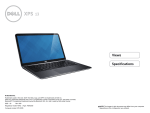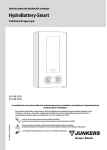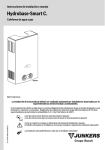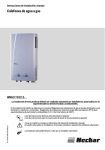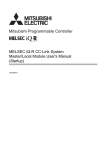Download DELL OptiPlex 3030
Transcript
OptiPlex 3030 All-in-One Owner's Manual Regulatory Model: W10B Regulatory Type: W10B001 Notes, Cautions, and Warnings NOTE: A NOTE indicates important information that helps you make better use of your computer. CAUTION: A CAUTION indicates either potential damage to hardware or loss of data and tells you how to avoid the problem. WARNING: A WARNING indicates a potential for property damage, personal injury, or death. Copyright © 2014 Dell Inc. All rights reserved. This product is protected by U.S. and international copyright and intellectual property laws. Dell™ and the Dell logo are trademarks of Dell Inc. in the United States and/or other jurisdictions. All other marks and names mentioned herein may be trademarks of their respective companies. 2014 - 06 Rev. A00 Contents 1 Working on Your Computer................................................................................5 Before Working Inside Your Computer................................................................................................ 5 Recommended Tools............................................................................................................................6 Turning Off Your Computer..................................................................................................................6 After Working Inside Your Computer................................................................................................... 7 2 System Overview...................................................................................................8 System Board Layout.............................................................................................................................9 3 Removing and Installing Components............................................................11 Removing the Stand.............................................................................................................................11 Installing the Stand...............................................................................................................................11 Removing the Back Cover................................................................................................................... 11 Installing the Back Cover.....................................................................................................................12 Removing the Optical Drive................................................................................................................ 12 Installing the Optical Drive.................................................................................................................. 13 Removing the Hard Drive.................................................................................................................... 13 Installing the Hard Drive...................................................................................................................... 15 Removing the Convertor Board..........................................................................................................15 Installing the Convertor Board............................................................................................................16 Removing the Memory........................................................................................................................16 Installing the Memory.......................................................................................................................... 17 Removing the System-Board Shield................................................................................................... 17 Installing the System-Board Shield.....................................................................................................18 Removing the Heatsink....................................................................................................................... 18 Installing the Heatsink......................................................................................................................... 19 Removing the Speakers.......................................................................................................................19 Installing the Speakers.........................................................................................................................21 Removing the VESA Bracket............................................................................................................... 22 Installing the VESA Bracket................................................................................................................. 22 Removing the System Fan.................................................................................................................. 22 Installing the System Fan.................................................................................................................... 23 Removing the Power-Switch Board...................................................................................................23 Installing the Power-Switch Board.....................................................................................................24 Removing the System Board.............................................................................................................. 24 Installing the System Board................................................................................................................ 26 Removing the Display Bracket............................................................................................................ 27 Installing the Display Bracket..............................................................................................................28 Removing the Camera........................................................................................................................ 29 Installing the Camera..........................................................................................................................30 Removing the Microphone.................................................................................................................30 Installing the Microphone................................................................................................................... 31 4 System Setup....................................................................................................... 32 Boot Sequence.................................................................................................................................... 32 Navigation Keys................................................................................................................................... 32 System Setup Options.........................................................................................................................33 Updating the BIOS .............................................................................................................................. 41 System and Setup Password...............................................................................................................42 Assigning a System Password and Setup Password.................................................................... 42 Deleting or Changing an Existing System and/or Setup Password.............................................43 5 Technical Specifications................................................................................... 44 6 Contacting Dell...................................................................................................49 Contacting Dell................................................................................................................................... 49 Working on Your Computer 1 Before Working Inside Your Computer Use the following safety guidelines to help protect your computer from potential damage and to help to ensure your personal safety. Unless otherwise noted, each procedure included in this document assumes that the following conditions exist: • You have read the safety information that shipped with your computer. • A component can be replaced or--if purchased separately--installed by performing the removal procedure in reverse order. WARNING: Disconnect all power sources before opening the computer cover or panels. After you finish working inside the computer, replace all covers, panels, and screws before connecting to the power source. WARNING: Before working inside your computer, read the safety information that shipped with your computer. For additional safety best practices information, see the Regulatory Compliance Homepage at www.dell.com/regulatory_compliance CAUTION: Many repairs may only be done by a certified service technician. You should only perform troubleshooting and simple repairs as authorized in your product documentation, or as directed by the online or telephone service and support team. Damage due to servicing that is not authorized by Dell is not covered by your warranty. Read and follow the safety instructions that came with the product. CAUTION: To avoid electrostatic discharge, ground yourself by using a wrist grounding strap or by periodically touching an unpainted metal surface, such as a connector on the back of the computer. CAUTION: Handle components and cards with care. Do not touch the components or contacts on a card. Hold a card by its edges or by its metal mounting bracket. Hold a component such as a processor by its edges, not by its pins. CAUTION: When you disconnect a cable, pull on its connector or on its pull-tab, not on the cable itself. Some cables have connectors with locking tabs; if you are disconnecting this type of cable, press in on the locking tabs before you disconnect the cable. As you pull connectors apart, keep them evenly aligned to avoid bending any connector pins. Also, before you connect a cable, ensure that both connectors are correctly oriented and aligned. NOTE: The color of your computer and certain components may appear differently than shown in this document. To avoid damaging your computer, perform the following steps before you begin working inside the computer. 1. Ensure that your work surface is flat and clean to prevent the computer cover from being scratched. 2. Turn off your computer (see Turning Off Your Computer). 5 CAUTION: To disconnect a network cable, first unplug the cable from your computer and then unplug the cable from the network device. 3. Disconnect all network cables from the computer. 4. Disconnect your computer and all attached devices from their electrical outlets. 5. Press and hold the power button while the computer is unplugged to ground the system board. 6. Remove the cover. CAUTION: Before touching anything inside your computer, ground yourself by touching an unpainted metal surface, such as the metal at the back of the computer. While you work, periodically touch an unpainted metal surface to dissipate static electricity, which could harm internal components. Recommended Tools The procedures in this document may require the following tools: • Small flat-blade screwdriver • Phillips screwdriver • Small plastic scribe Turning Off Your Computer CAUTION: To avoid losing data, save and close all open files and exit all open programs before you turn off your computer. 1. Shut down the operating system: • In Windows 8: – Using a touch-enabled device: a. Swipe in from the right edge of the screen, opening the Charms menu and select Settings. b. Select the and then select Shut down – Using a mouse: • a. Point to upper-right corner of the screen and click Settings. b. Click the and select Shut down. In Windows 7: . 1. Click Start 2. Click Shut Down. or 1. 6 Click Start . 2. 2. Click the arrow in the lower-right corner of the Start menu as shown below, and then click Shut Down.. Ensure that the computer and all attached devices are turned off. If your computer and attached devices did not automatically turn off when you shut down your operating system, press and hold the power button for about 6 seconds to turn them off. After Working Inside Your Computer After you complete any replacement procedure, ensure you connect any external devices, cards, and cables before turning on your computer. 1. Replace the cover. CAUTION: To connect a network cable, first plug the cable into the network device and then plug it into the computer. 2. Connect any telephone or network cables to your computer. 3. Connect your computer and all attached devices to their electrical outlets. 4. Turn on your computer. 5. If required, verify that the computer works correctly by running the Dell Diagnostics. 7 System Overview Figure 1. Inside View – 1 1. memory shield 2. system board shield 3. bottom cover 4. power-switch board 5. hard drive 6. VESA Bracket 7. optical drive 8. convertor board 8 2 Figure 2. Inside View – 2 1. WLAN card 2. memory module 3. power supply unit 4. system board 5. speaker 6. display bracket 7. system fan 8. heatsink 9. camera 10. microphone System Board Layout The following image displays the system board layout of the computer. 9 1. SD Memory card reader 2. memory module 3. speaker connector 4. touch connector 5. control board connector 6. HDD connector 7. ODD connector 8. SATA power connector 9. convertor board connector 10. power connector 2 11. power connector 1 12. system fan connector 13. processor connector 14. coin-cell Battery 15. WLAN connector 16. LVDS connector 17. camera 10 Removing and Installing Components 3 This section provides detailed information on how to remove or install the components from your computer. Removing the Stand 1. Follow the procedures in Before Working Inside Your Computer. 2. Remove the stand cover. 3. Remove the screws that secure the stand to the computer and remove the stand from the computer. Installing the Stand 1. Align the stand on the computer, and tighten the screws to secure the stand to the computer. 2. Place and press the panel on the computer until it clicks into place. 3. Install stand cover. 4. Follow the procedures in After Working Inside Your Computer. Removing the Back Cover 1. Follow the procedures in Before Working Inside Your Computer. 2. Remove: a. stand cover b. stand 3. Perform the following steps as shown in the illustration: a. Using a scribe, pry the edges of the computer [1]. 11 b. Remove the back cover from the computer [2]. Installing the Back Cover 1. Place the back cover on the computer. 2. Press at the corners of the back cover to secure it to the computer. 3. Install: a. stand b. stand cover 4. Follow the procedures in After Working Inside Your Computer. Removing the Optical Drive 1. Follow the procedures in Before Working Inside Your Computer. 2. Remove: a. stand cover b. stand c. back cover 3. 12 Remove the screw that secures the optical drive to the computer . Slide the optical drive out of the computer. Installing the Optical Drive 1. Slide the optical drive to the computer and tighten the screw to secure it. 2. Install: a. back cover b. stand c. stand cover 3. Follow the procedures in After Working Inside Your Computer. Removing the Hard Drive 1. Follow the procedures in Before Working Inside Your Computer. 2. Remove: a. stand cover b. stand c. back cover 3. Perform the following steps as shown in the illustration: a. Push the hard-drive bracket to release it from its lock [1]. b. Lift the hard drive from one edge [2]. 13 4. Slide and remove it to access the hard-drive cable. 5. Disconnect the hard-drive cable from the hard drive, and remove it from the computer. 6. Pry the hard-drive bracket apart to release the hard drive. Remove the hard drive from the hard-drive bracket. 14 Installing the Hard Drive 1. Insert the hard drive into the hard-drive bracket. 2. Connect the hard-drive cable to the hard drive and align the hard drive to its slot on the computer. 3. Install: a. back cover b. stand c. stand cover 4. Follow the procedures in After Working Inside Your Computer. Removing the Convertor Board 1. Follow the procedures in Before Working Inside Your Computer. 2. Remove: a. stand cover b. stand c. back cover 3. Disconnect the cables from the convertor board. Remove the screws and lift the convertor board from the computer. 15 Installing the Convertor Board 1. Tighten the screws to secure the convertor board to the computer. Connect the cables to the convertor board. 2. Install: a. back cover b. stand c. stand cover 3. Follow the procedures in After Working Inside Your Computer. Removing the Memory 1. Follow the procedures in Before Working Inside Your Computer. 2. Remove: a. stand cover b. stand c. back cover 3. Perform the following steps as shown in the illustration: a. Slide to release the memory cover from the computer [1]. b. Remove the memory cover from the computer [2]. 16 4. Pry the retention clips away from the memory module until it pops up. Lift and remove the memory module from its connector. Installing the Memory 1. Align the notch on the memory-card with the tab in the system-board connector. 2. Press down on the memory module until the release tabs spring back to secure them in place. 3. Place the memory cover back into its place. 4. Install: a. back cover b. stand c. stand cover 5. Follow the procedures in After Working Inside Your Computer. Removing the System-Board Shield 1. Follow the procedures in Before Working Inside Your Computer. 2. Remove: a. stand cover b. stand c. back cover 3. Perform the following steps as shown in the illustration: a. Remove the screws that secure the system-board shield to the computer [1]. b. Lift the system-board shield from the computer [2]. c. Remove the system-board shield from the computer [3]. 17 Installing the System-Board Shield 1. Align the system-board shield on the system board. Tighten the screws to secure it to the computer. 2. Install: a. back cover b. stand c. stand cover 3. Follow the procedures in After Working Inside Your Computer. Removing the Heatsink 1. Follow the procedures in Before Working Inside Your Computer. 2. Remove: a. b. c. d. 3. stand cover stand back cover system-board shield Perform the following steps as shown in the illustration:. a. Remove the screw that secure the heatsink to the computer [1]. b. Remove the screws that secure around CPU to the computer [2]. c. Lift and remove the heatsink from the computer [3]. 18 Installing the Heatsink 1. Align the heatsink on the system board. Tighten the screws to secure it to the computer. 2. Install: a. b. c. d. 3. system-board shield back cover stand stand cover Follow the procedures in After Working Inside Your Computer. Removing the Speakers 1. Follow the procedures in Before Working Inside Your Computer. 2. Remove: a. b. c. d. 3. stand cover stand back cover system-board shield Perform the following steps as shown in the illustration: a. Remove the screws that secure the speaker cover to the computer [1]. b. Release the speaker cover from the computer.[2]. 19 4. Remove the speaker cover from the computer. 5. Perform the following steps as shown in the illustration: a. Disconnect the speaker cable from the system board [1]. b. Release the cable from the tabs on the computer [2]. 20 6. Perform the following steps as shown in the illustration: a. Remove the screws that secure the speakers to the computer [1]. b. Remove the speakers from the computer [2]. Installing the Speakers 1. Align the speakers on the computer. Tighten the screws to secure them to the computer. 2. Align the speaker cables through their tabs on the computer and connect the speaker cable to the system board. 3. Align the speaker cover on the computer and tighten the screws to secure it. 4. Install: a. system-board shield 21 b. back cover c. stand d. stand cover 5. Follow the procedures in After Working Inside Your Computer. Removing the VESA Bracket 1. Follow the procedures in Before Working Inside Your Computer. 2. Remove: a. stand cover b. stand c. back cover 3. Perform the following steps as shown in the illustration: a. Remove the screws that secure the VESA bracket to the computer [1]. b. Remove the VESA it from the computer [2]. Installing the VESA Bracket 1. Align the VESA bracket on the computer. Tighten the screws to secure it to the computer. 2. Install: a. back cover b. stand c. stand cover 3. Follow the procedures in After Working Inside Your Computer. Removing the System Fan 1. Follow the procedures in Before Working Inside Your Computer. 2. Remove: 22 a. b. c. d. e. 3. stand cover stand back cover System-board shield VESA bracket Perform the following steps as shown in the illustration: a. Disconnect the system-fan cable from the system board [1]. b. Remove the screws that secure the system fan [2]. c. Remove system fan from the computer [3]. Installing the System Fan 1. Align the system fan with the heatsink on the computer and tighten the screws to secure it to the computer. 2. Connect the system-fan cable to the system board. 3. Install: a. b. c. d. e. 4. VESA bracket system-board shield back cover stand stand cover Follow the procedures in After Working Inside Your Computer. Removing the Power-Switch Board 1. Follow the procedures in Before Working Inside Your Computer. 2. Remove: a. stand cover b. stand c. back cover 3. Peel the tape that secures the power-switch board to the computer. Lift the power-switch board to access the cable. 23 4. Disconnect the power-switch cable from the power-switch board to remove it from the computer. Installing the Power-Switch Board 1. Insert the power-switch board into its slot on the computer and fix the tape to secure it. Connect the power-switch cable to the power-switch board. 2. Install: a. back cover b. stand c. stand cover 3. Follow the procedures in After Working Inside Your Computer. Removing the System Board 1. Follow the procedures in Before Working Inside Your Computer. 2. Remove: a. stand cover b. stand 24 c. d. e. f. g. h. 3. Disconnect the following from the system board: a. b. c. d. e. f. g. h. i. j. 4. back cover memory VESA bracket system-board shield heatsink WLAN card camera cable LVDS cable system-fan cable optical-drive cable hard-drive cable hard-drive/optical-drive power cable convertor-board cable power-switch cable touch cable (if available) speaker cable Perform the following steps as shown in the illustration: a. Remove the screws that secure the system board to the computer [1]. b. Slide the system board to release it from the computer [2]. 25 5. Remove the system board from the computer. Installing the System Board 1. Align the system board on the computer. 2. Tighten the screws to secure the system board to the computer. 3. Connect the following cables to the system board: a. b. c. d. e. 26 camera cable LVDS cable system fan cable optical-drive cable hard-drive cable f. g. h. i. j. 4. Install: a. b. c. d. e. f. g. h. 5. hard-drive/optical-drive power cable convertor-board cable touch cable (if available) power-switch cable speaker cable WLAN card heatsink system-board shield VESA bracket memory back cover stand stand cover Follow the procedures in After Working Inside Your Computer. Removing the Display Bracket 1. Follow the procedures in Before Working Inside Your Computer. 2. Remove: a. b. c. d. e. f. g. h. i. j. k. l. m. n. 3. stand cover stand back cover optical drive hard drive memory VESA bracket system-board shield speakers heatsink system fan WLAN card convertor board system board Release the LVDS, camera, convertor-board cables from their tabs on the display bracket. 27 4. Remove the screws that secure the display bracket to the computer. Lift and remove the display bracket from the computer. Installing the Display Bracket 1. Align the display bracket on the computer. 2. Tighten the screws to secure the display bracket to the computer. 3. Align the LVDS, camera, convertor-board cables through their tabs on the display bracket. 4. Install: a. system board b. convertor board c. WLAN card 28 d. e. f. g. h. i. j. k. l. m. n. 5. system fan heatsink speakers system-board shield VESA bracket memory hard drive optical drive back cover stand stand cover Follow the procedures in After Working Inside Your Computer. Removing the Camera 1. Follow the procedures in Before Working Inside Your Computer. 2. Remove: a. b. c. d. e. f. g. h. i. j. k. l. m. n. o. 3. stand cover stand back cover optical drive hard drive memory VESA bracket system-board shield speakers heatsink system fan WLAN card convertor board system board display bracket Remove the screws that secure the camera to the computer and release the camera from its slot to access the camera cable. 29 4. Disconnect the camera cable from the camera and remove the camera from the computer. Installing the Camera 1. Connect the camera cable to the camera. 2. Align the camera into its slot and tighten the screws to secure it to the computer. 3. Install: a. b. c. d. e. f. g. h. i. j. k. l. m. n. o. 4. display bracket system board convertor board WLAN card system fan heatsink speakers system-board shield VESA bracket memory hard drive optical drive back cover stand stand cover Follow the procedures in After Working Inside Your Computer. Removing the Microphone 1. Follow the procedures in Before Working Inside Your Computer. 2. Remove: a. stand cover b. stand c. back cover 3. 30 Perform the following steps as shown in the illustration: a. Remove the screw that secures the microphone. b. Disconnect the microphone cable from the microphone. c. Remove the microphone from the computer. Installing the Microphone 1. Connect the microphone cable to the microphone. 2. Align the microphone into its slot and tighten the screws to secure it to the computer. 3. Install: a. back cover b. stand c. stand cover 4. Follow the procedures in After Working Inside Your Computer. 31 System Setup 4 System Setup enables you to manage your computer hardware and specify BIOS‐level options. From the System Setup, you can: • Change the NVRAM settings after you add or remove hardware • View the system hardware configuration • Enable or disable integrated devices • Set performance and power management thresholds • Manage your computer security Boot Sequence Boot Sequence allows you to bypass the System Setup‐defined boot device order and boot directly to a specific device (for example: optical drive or hard drive). During the Power-on Self Test (POST), when the Dell logo appears, you can: • Access System Setup by pressing <F2> key • Bring up the one-time boot menu by pressing <F12> key The one-time boot menu displays the devices that you can boot from including the diagnostic option. The boot-menu options are: • Removable Drive (if available) • STXXXX Drive NOTE: XXX denotes the SATA drive number. • Optical Drive • Diagnostics NOTE: Choosing Diagnostics, will display the ePSA diagnostics screen. The boot sequence screen also displays the option to access the System Setup screen. Navigation Keys The following table displays the system setup navigation keys. NOTE: For most of the system setup options, changes that you make are recorded but do not take effect until you re-start the system. 32 Table 1. Navigation Keys Keys Navigation Up arrow Moves to the previous field. Down arrow Moves to the next field. <Enter> Allows you to select a value in the selected field (if applicable) or follow the link in the field. Spacebar Expands or collapses a drop‐down list, if applicable. <Tab> Moves to the next focus area. NOTE: For the standard graphics browser only. <Esc> Moves to the previous page till you view the main screen. Pressing <Esc> in the main screen displays a message that prompts you to save any unsaved changes and restarts the system. <F1> Displays the System Setup help file. System Setup Options NOTE: Depending on your computer and its installed devices, the items listed in this section may or may not appear. Table 2. General Option Description System Board This section lists the primary hardware features of your computer. • • • • • Boot Sequence System Information Memory Information PCI Information Processor Information Device Information Allows you to change the order in which the computer attempts to find an operating system. • Boot Sequence • • • • • Diskette drive SATA HDD Drive USB Storage Device CD/DVD/CD-RW Drive Onboard NIC • • Boot List Option Allows you to change the boot list option. – Legacy – UEFI Advanced Boot Options Allows you to Enable Legacy Option ROMs 33 Option Description • Date/Time Enabled Legacy Options ROMs (Default: Enabled) Allows you to set the date and time. The changes to the system date and time takes effect immediately. Table 3. System Configuration Option Description Integrated NIC Allows you to configure the integrated network controller. The options are: • • • • • SATA Operation Allows you to configure the internal SATA harddrive controller. The options are: • • • Drives Enable UEFI Network Stack Disabled Enabled Enabled w/PXE (Default) Enabled w/Cloud Desktop Disabled ATA AHCI (Default) Allows you to enable or disable the various drives on-board: • • SATA-0 SATA-1 Default Setting: All drives are enabled. SMART Reporting Allows you to enable SMART reporting on hard drives during system startup. • USB Configuration Enable SMART Reporting - This option is disabled by default. Allows you to enable or disable the internal USB configuration. The options are: • • Enable Boot Support Rear USB Ports • – Port 1 (left) – Port 2 (Center Left) – Port 3 (Center Right) – Port 4 (Right) Side USB Ports – Port 1 (Top) – Port 2 (Bottom) 34 Option Description Default Setting: All devices are enabled. Audio Allows you enable or disable the audio feature. • Enable Audio – Enable Microphone – Enable Internal Speaker Default Setting: All devices are enabled. OSD Button Management Allows you to disable the OSD (On-Screen Display) buttons. • Disable OSD Buttons Default Setting: OSD buttons are not disabled Miscellaneous Devices Allows you to enable or disable various on-board devices. • • • Enable Camera - This option is selected by default. Enable Media Card - This option is selected by default. Disable Media Card Table 4. Security Option Description Admin Password This field lets you set, change, or delete the administrator (admin) password (sometimes called the setup password). The admin password enables several security features. The drive does not have a password set by default. • • • System Password This field lets you set, change, or delete the system password. The system password enables several security features. The drive does not have a password set by default. • • • Internal HDD_0 Password Enter the old password Enter the new password Confirm the new password Enter the old password Enter the new password Confirm the new password Allows you to set, change, or delete the password on the computer’s internal hard disk drive (HDD) Successful change to this password take effect immediately. The drive does not have a password set by default • • Enter the old password Enter the new password 35 Option Description • Confirm the new password Strong Password Enable strong password - This option is disabled by default. Password Configuration This field controls the minimum and maximum number of characters allowed for the admin and system passwords. • • • • Admin Password Min Admin Password Max System Password Min System Password Max By default the minimum characters are set to 4 and maximum to 32. Password Bypass Allows you to bypass the System Password and the internal HDD password prompts during a system restart. • • Password Change Disabled - This option is selected by default. Reboot Bypass Allows you to determine whether changes to the system and hard disk passwords are permitted when an administrator password is set. • Allow Non-Admin Password Changes - This option is enabled by default. TPM Security Allows you to control whether the Trusted Platform Module (TPM) in the system is enabled and visible to the operating system. TPM Security - This option is disabled by default. Computrace Allows you to activate, deactivate or disable the BIOS module interface of the optional Computrace Service from Absolute Software. • • • CPU XD Support Allows you to enable or disable the execute disable mode of the processor. • Admin Setup Lockout Enable CPU XD Support - This option is enabled by default. Allows you to enable or disable the option to enter setup when an admin password is set. • 36 Deactivate - This option is disabled by default. Disable Activate Enable Admin Setup Lockout - This option is disabled by default. Table 5. Secure Boot Option Description Secure Boot Enable Allows you to enable or disable the Secure Boot Feature. The options are: • • Expert Key Management Disabled (Default) Enabled Allows you to manipulate the security key databases only if the system is in Custom Mode. The Enable Custom Mode option is disabled by default. The options are: • • • • PK KEK db dbx If you enable the Custom Mode, the relevant options for PK, KEK, db, and dbx appear. The options are: • • • • • • Save to File- Saves the key to a user-selected file Replace from File- Replaces the current key with a key from a user-selected file Append from File- Adds a key to the current database from a user-selected file Delete- Deletes the selected key Reset All Keys- Resets to default setting Delete All Keys- Deletes all the keys NOTE: If you disable the Custom Mode, all the changes made will be erased and the keys will restore to default settings. Table 6. Performance Option Description Multi Core Support Specifies whether the process will have one or all cores enabled. The performance of some applications will improve with the additional cores. • • • All - Enabled by default 1 2 Intel SpeedStep Allows you to enable or disable the Intel SpeedStep feature. Default Setting: Enable Intel SpeedStep C States Control Allows you to enable or disable the additional processor sleep states. Default Setting: Enabled 37 Option Description Limit CPUID Value This field limits the maximum value the processor Standard CPUID Function will support • Enable CPUID Limit (Disabled by default) NOTE: Some Operating system will not complete installation when the maximum CPUID Function is greater than 3 Intel TurboBoost Allows you to enable or disable Intel TurboBoost mode of the processor. This option is enabled by default. • Enable Intel TurboBoost - Allows the Intel TurboBoost driver to increase the performance of the CPU or graphics processor. Enabled by default. Table 7. Power Management Option Description AC Recovery Specifies how the computer will respond when AC power is applied after a AC power loss. You can set the AC Recovery to: • • • Auto On Time Allows you to set the time at which the computer must turn on automatically. The options are: • • • • Deep Sleep Control Enable USB Wake Support - This option is enabled by default. Allows you to power up the computer from the off state when triggered by a special LAN/WLAN signal. • 38 Fan Control Override This option is disabled by default. This option allows you to enable USB devices to wake the computer from standby. • Wake on LAN/WLAN Disabled Enabled in S5 only Enabled in S4 and S5 Enabled Controls the speed of the system fan. This option is disabled by default. • USB Wake Support Disabled (Default) Every Day Weekdays Select Days Allows you to define the controls when Deep Sleep is enabled. • • • Fan Control Override Power Off (Default) Power On Last Power State Disabled Option Description • • • LAN Only WLAN only LAN with PXE Boot This option is Disabled by default. Block Sleep Allows you to block entering to sleep (S3 state) in OS Environment. • Intel Smart Connect Technology Block Sleep (S3 State) This option is disabled by default. The option is disabled by default. If option enables will periodically sense nearby wireless connection while the system is asleep. It will synchronize emails or social media application that were open when system entered the sleep state. • Smart Connection Table 8. POST Behavior Option Description Numlock LED Allows you to enable NumLock on when the computer boots. This option is enabled by default. • Keyboard Errors Allows you to enable keyboard related error report when the computer boots. This option is enabled by default. • Fastboot Enable Numlock LED Enable Keyboard Error Detection Allows you to speed up the boot process by bypassing some compatibility steps. The options are: • • • Minimal Thorough - This option is selected by default. Auto Table 9. Virtualization Support Option Description Virtualization This option specifies whether a Virtual Machine Monitor (VMM) can utilize the additional hardware capabilities provided by Intel Virtualization technology. • Enable Intel Virtualization Technology - This option is enabled by default. Table 10. Wireless Option Description Wireless Device Enable Allows enabling/disabling the internal wireless devices. The options are is WLAN/WIGIG(enabled by default) 39 Table 11. Maintenance Option Description Service Tag Displays the service tag of your computer. Asset Tag Allows you to create a system asset tag if an asset tag is not already set. This option is not set by default. SERR Messages Controls the SERR message mechanism. This option is enabled by default. Some graphics cards require that the SERR message mechanism be disabled. • Enable SERR Messages Table 12. Cloud Desktop Option Description Server Lookup Method Specifies how the ImageServer looks up the server address. • • Static IP DNS (enabled by default) NOTE: This field is only relevant when the Integrated NIC control in the System Configuration group is set to Enabled with ImageServer. Server Name Displays the name of the server. Server IP Address Displays the primary static IP address of the ImageServer with which the client software communicates. The default IP address is 255.255.255.255. NOTE: This field is only relevant when the Integrated NIC control in the System Configuration group is set to Enabled with ImageServer and when Lookup Method is set to Static IP. Server Port Displays the primary IP port of the ImageServer, which is used by the client to communicate. The default IP port is 06910. NOTE: This field is only relevant when the Integrated NIC control in the System Configuration group is set to Enabled with ImageServer. Client Address Method Specifies how the client obtains the IP address. • • Static IP DHCP (enabled by default) NOTE: This field is only relevant when the Integrated NIC control in the System Configuration group is set to Enabled with ImageServer. Client IP Address 40 Displays the static IP address of the client. The default IP address is 255.255.255.255. Option Description NOTE: This field is only relevant when the Integrated NIC control in the System Configuration group is set to Enabled with ImageServer and when Client DHCP is set to Static IP. Client SubnetMask Displays the subnet mask of the client. The default setting is 255.255.255.255. NOTE: This field is only relevant when the Integrated NIC control in the System Configuration group is set to Enabled with ImageServer and when Client DHCP is set to Static IP. Client Gateway Displays the gateway IP address for the client. The default setting is 255.255.255.255. NOTE: This field is only relevant when the Integrated NIC control in the System Configuration group is set to Enabled with ImageServer and when Client DHCP is set to Static IP. DNS IP Address Displays the DNS IP address of the cleint. The default setting is 255.255.255.255. Domain Name Displays the Domain Name of the client. Advanced Specifies for Advanced debugging • Verbose Mode (Disabled by default) Table 13. System Logs Option Description BIOS events Displays the system event log and allows you to clear the log. • Clear Log Updating the BIOS It is recommended to update your BIOS (system setup), on replacing the system board or if an update is available. For laptops, ensure that your computer battery is fully charged and connected to a power outlet 1. Re-start the computer. 2. Go to dell.com/support. 3. Enter the Service Tag or Express Service Code and click Submit. NOTE: To locate the Service Tag, click Where is my Service Tag? NOTE: If you cannot find your Service Tag, click Detect My Product. Proceed with the instructions on screen. 4. If you are unable to locate or find the Service Tag, click the Product Category of your computer. 5. Choose the Product Type from the list. 41 6. Select your computer model and the Product Support page of your computer appears. 7. Click Get drivers and click View All Drivers. The Drivers and Downloads page opens. 8. On the Drivers and Downloads screen, under the Operating System drop-down list, select BIOS. 9. Identify the latest BIOS file and click Download File. You can also analyze which drivers need an update. To do this for your product, click Analyze System for Updates and follow the instructions on the screen. 10. Select your preferred download method in the Please select your download method below window; click Download File. The File Download window appears. 11. Click Save to save the file on your computer. 12. Click Run to install the updated BIOS settings on your computer. Follow the instructions on the screen. System and Setup Password You can create a system password and a setup password to secure your computer. Password Type Description System password Password that you must enter to log on to your system. Setup password Password that you must enter to access and make changes to the BIOS settings of your computer. CAUTION: The password features provide a basic level of security for the data on your computer. CAUTION: Anyone can access the data stored on your computer if it is not locked and left unattended. NOTE: Your computer is shipped with the system and setup password feature disabled. Assigning a System Password and Setup Password You can assign a new System Password and/or Setup Password or change an existing System Password and/or Setup Password only when Password Status is Unlocked. If the Password Status is Locked, you cannot change the System Password. NOTE: If the password jumper is disabled, the existing System Password and Setup Password is deleted and you need not provide the system password to log on to the computer. To enter a system setup, press <F2> immediately after a power-on or re-boot. 1. In the System BIOS or System Setup screen, select System Security and press <Enter>. The System Security screen appears. 2. In the System Security screen, verify that Password Status is Unlocked. 3. Select System Password , enter your system password, and press <Enter> or <Tab>. Use the following guidelines to assign the system password: 42 • A password can have up to 32 characters. • The password can contain the numbers 0 through 9. • Only lower case letters are valid, upper case letters are not allowed. • Only the following special characters are allowed: space, (”), (+), (,), (-), (.), (/), (;), ([), (\), (]), (`). Re-enter the system password when prompted. 4. Type the system password that you entered earlier and click OK. 5. Select Setup Password, type your system password and press <Enter> or <Tab>. A message prompts you to re-type the setup password. 6. Type the setup password that you entered earlier and click OK. 7. Press <Esc> and a message prompts you to save the changes. 8. Press <Y> to save the changes. The computer reboots. Deleting or Changing an Existing System and/or Setup Password Ensure that the Password Status is Unlocked (in the System Setup) before attempting to delete or change the existing System and/or Setup password. You cannot delete or change an existing System or Setup password, if the Password Status is Locked. To enter the System Setup, press <F2> immediately after a power-on or reboot. 1. In the System BIOS or System Setup screen, select System Security and press <Enter>. The System Security screen is displayed. 2. In the System Security screen, verify that Password Status is Unlocked. 3. Select System Password, alter or delete the existing system password and press <Enter> or <Tab>. 4. Select Setup Password, alter or delete the existing setup password and press <Enter> or <Tab>. NOTE: If you change the System and/or Setup password, re-enter the new password when promoted. If you delete the System and/or Setup password, confirm the deletion when promoted. 5. Press <Esc> and a message prompts you to save the changes. 6. Press <Y> to save the changes and exit from the System Setup. The computer reboots. 43 Technical Specifications 5 NOTE: Offerings may vary by region. The following specifications are only those required by law to ship with your computer. For more information about the configuration of your computer, go to Help and Support in your Windows operating system and select the option to view information about your computer. Table 14. System Information Feature Specification Processor type • • • Total cache Up to 6 MB cache depending on processor type Chipset Intel H81 Chipset Intel Core i3 / i5 series Intel Celeron Dual Core Intel Pentium Dual Core Table 15. Memory Feature Specification Type up to 1600 MHz, unbuffered non-ECC, dual‑channel DDR3 configuration Connectors two internally-accessible DDR3 SODIMM sockets Capacity 2 GB, 4 GB, and 8 GB Minimum Memory 2 GB Maximum Memory 16 GB Table 16. Video Feature Specification Video Controller: Integrated Discrete • Integrated Intel HD Graphics 4600 - Intel Core i5 • Integrated Intel HD Graphics 4400 - Intel Core i3 • Integrated Intel HD Graphics - Intel Pentium/ Celeron Dual Core AMD Radeon R5 A240 Video Memory: Integrated 44 shared memory Feature Discrete Specification 1 GB DDR3 Table 17. Audio Feature Specification Controller ALC3661-CG (Realtek) Speaker single 4-ohms, 2 W AVG speakers with 2.5 W Peak Internal speaker amplifier up to 6 W per channel Internal microphone support single digital microphone Volume controls Volume up/down buttons (Windows 7 only), program menus, and keyboard media-control keys Table 18. Communications Feature Specification Network adapter Intel 10/100/1000 Mbps Ethernet LAN on system board Wireless half mini-card • Wi-Fi 7260 agn/ac Table 19. Cards Feature Specification M.2 one Table 20. Displays Feature Specification Type 19.5 inch HD+ WLED Maximum resolution 1600 x 900 Refresh rate 60 Hz Operating angle 170° (horizontal) / 160° (vertical) Pixel pitch 0.27 mm Dimensions: Height 236.30 mm (9.30 inches) Width 433.90 mm (17.08 inches) Diagonal 495.30 mm (19.50 inches) 45 Table 21. Drives Feature Specification Hard drive one 2.5-inch SATA drive Optical drive (optional) one DVD-ROM, DVD+/- RW Table 22. Ports and Connectors Feature Specification Audio: one universal audio jack/Line-out port Network adapter one RJ45 connector USB 2.0 four connectors in the back panel USB 3.0 two connectors on the side panel Media card reader one 4-in-1 slot Table 23. Power Feature Specification Type 180 W Frequency 50 Hz - 60 Hz Voltage 100 VAC - 240 VAC Rated output voltage 19.50 VDC Input current 2.9 A Maximum Output current +12.0 V output (+12VA – 10A & +12VB – 14.5A) NOTE: +12VB Rated at 0.4 A when in Standby Mode. Dimensions: Height 30.00 mm (1.18 inches) Width 76.20 mm (3.00 inches) Depth 155.00 mm (6.10 inches) Weight 0.58 kg (1.28 lb) Temperature range: Operating 0 °C to 35 °C (30 °F to 95 °F) Storage -40 °C to 70 °C (-40 °F to 158 °F) Coin-cell battery 46 3 V CR2032 lithium coin cell Table 24. Camera (optional) Feature Specification Image resolution 0.92 megapixel Video resolution 720p @ 30 FPS HD Diagonal viewing angle 74 degrees Table 25. Stand Feature Specification Tilt –5 degrees to 30 degrees Table 26. Physical Dimensions Feature Without Stand With Stand Width 489.92 mm (19.29 inches) 489.92 mm (19.29 inches) Height 328.84 mm (12.95 inches) 385.58 mm (15.18 inches) non-touch 67.62 mm (2.66 inches) 204.58 mm (8.05 inches) touch 66.72 mm (2.63 inches) 204.97 mm (8.07 inches) Depth: Weight: non-touch 4.18 kg to 4.37 kg (9.21 lb to 9.63 lb) 5.68 kg to 5.87 kg ( 12.52 lb to 12.94 lb) touch 4.87 kg to 5.06 kg (10.74 lb to 11.15 lb) Stand (Width x Depth) 6.37 kg to 6.56 kg (14.04 lb to 14.46 lb) 200.00 mm (7.87 inches) x 200.00 mm (7.87 inches) NOTE: The weight of your computer may vary depending on the configuration ordered and the manufacturing variability. Table 27. Controls and Lights Feature Specification Power button light White light — Solid white light indicates power-on state; blinking white light indicates sleep state of the computer. Hard Drive activity light White light — Blinking white light indicates that the computer is reading data from or writing data to the hard drive. Camera LED White light — solid while light indicates that the camera is on. 47 Feature Specification Back panel: Link integrity light on integrated network adapter : Green — a good 10 Mbps connection exists between the network and the computer. Green— a good 100 Mbps connection exists between the network and the computer. Orange — a good 1000 Mbps connection exists between the network and the computer. Off (no light) — the computer is not detecting a physical connection to the network. Network activity light on integrated network adapter Yellow light — A blinking yellow light indicates that network activity is present. Power supply diagnostic light Green light — The power supply is turned on and is functional. The power cable must be connected to the power connector (at the back of the computer) and the electrical outlet. Table 28. Environmental Feature Specification Temperature range: Operating 5 °C to 35 °C (41 °F to 95 °F) Storage –40 °C to 65 °C (–40 °F to 149 °F) Relative humidity (maximum): Operating 10% to 90% (non-condensing) Storage 10% to 95% (non-condensing) Maximum vibration: Operating 0.66 GRMS Storage 1.30 GRMS Maximum shock: Operating 110 G Storage 160 G Altitude: Operating –15.20 m to 3048 m (–50 ft to 10,000 ft) Storage –15.20 m to 10,668 m (–50 ft to 35,000 ft) Airborne contaminant level 48 G2 or lower as defined by ANSI/ISA-S71.04-1985 Contacting Dell 6 Contacting Dell NOTE: If you do not have an active Internet connection, you can find contact information on your purchase invoice, packing slip, bill, or Dell product catalog. Dell provides several online and telephone-based support and service options. Availability varies by country and product, and some services may not be available in your area. To contact Dell for sales, technical support, or customer service issues: 1. Visit dell.com/support 2. Select your support category. 3. Verify your country or region in the Choose a Country/Region drop-down menu at the top of page. 4. Select the appropriate service or support link based on your need. 49


















































